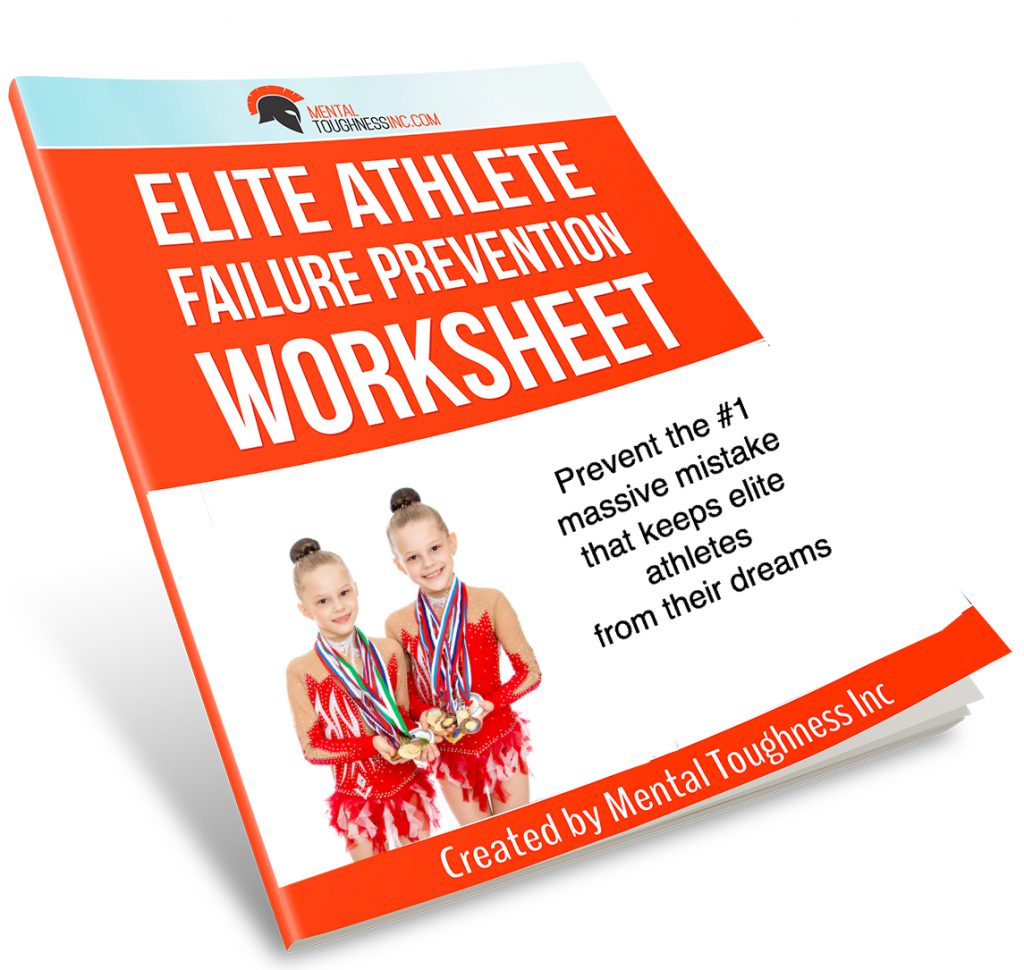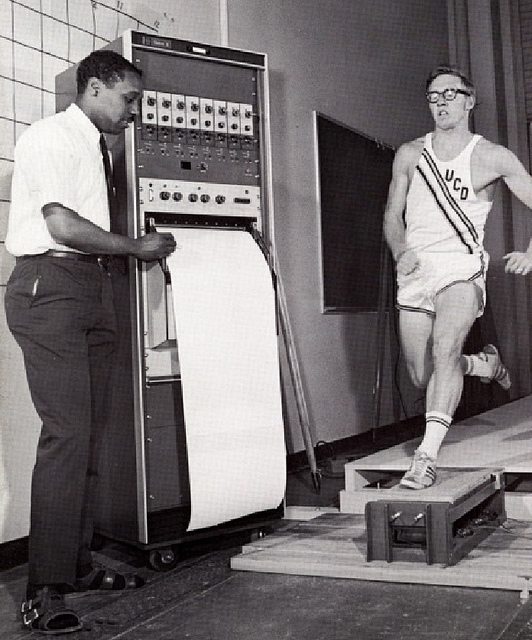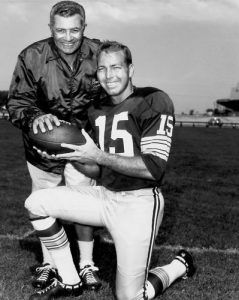
The words “I can’t” are often heard in the gym. But the gymnast who says they can’t doesn’t say it because they physically can’t try a new move. The words “I can’t” don’t represent a lack of ability or physical strength at all.
“I can’t” represents fear and anxiety. They’re totally natural responses to trying something new, especially in gymnastics.
Remember, gymnastics isn’t like tennis or volleyball. Gymnastics holds significantly more risk than virtually any other sport.
Gymnasts at any level can hurt themselves in any number of ways every time they show up for practice.
The likelihood that a young gymnast will fall on their head, face, back, knees, or anywhere else from a serious height is far more significant than any sport.
So learning to positively deal with negative feelings like fear? You signed up for that when you dropped your child off at their very first lesson.
Fear and Anxiety: It Happens to Everyone
Your young gymnast is not alone in their fears and anxieties.
In fact, it would be hard to find a gymnast who was never afraid performing of a particular skill.
It’s worth reiterating that gymnastics requires gymnasts to use every muscle in their body to throw their bodies upside down and twist them around while attempting to land on a piece of wood 3 inches thick.
Did we mention they do all this backwards, too?
Oh, and they need to smile when they do it.
Even elite gymnasts, like seven-time Olympic gold medalist and gymnastics icon Shannon Miller or tumbling phenom Simone Biles experience fear and anxiety in the gym.
The first thing to understand about fear and encouraging your young gymnast is recognizing that everyone is afraid sometimes.
Being afraid doesn’t mean they’re weaker than other gymnasts. It certainly doesn’t mean they don’t have what it takes to succeed.
It’s natural. In fact, fear is useful.
Fear Is A Gymnast’s Best Friend (After Chalk)
Fear keeps gymnasts from flinging themselves off the bars attempting a skill they’re nowhere near ready for. It prevents injuries. Being scared sometimes keeps you safe.
Relating the message that fear is natural is important not because gymnasts should be allowed to be perpetually afraid.
Giving them the confidence to let you know their scared is important so you can help them fix the problem.
Lashing out or shaming them doesn’t help. It only makes them afraid to tell you they’re anxious or nervous, which adds to the negative feelings.
Compounding negativity takes the fun out of sport – and that’s where they’re there.
Instead, help them get over their fears by allowing you to help them work through it using various strategies for overcoming fear.
Why You Shouldn’t Force Them Through Fear
The worst thing you can do as a coach or parent of a young gymnast is to force the child to perform the skill there and then when they’re afraid.
It often seems like the right thing to do.
How often do parents throw their children into the pool to teach them to swim?
Well, that doesn’t work in gymnastics.
Here’s why:
According to research published in the Journal of Clinical Sport Psychology, fear and anxiety in gymnastics often result in a skill block during movement or execution.
That manifestation of worry is important. Gymnasts have two options when they go for a skill.
- The first option is to commit to it 100%.
- The second option is to bail and practice a modified version of the skill in a safer space.
But what about the 99% in between?
There is no halfway in gymnastics. Committing halfway to a skill, regardless of the difficulty or where it’s performed, never goes well. In some cases, it leads to a half-hearted attempt with bad form. Too often, it results in injuries whether temporary or otherwise.
Either way, going 50% of the way never looks pretty.
Here’s another reason force doesn’t work in gymnastics like it does at the pool. If your child flails around in the water before starting to drown, you go in after them. They get a little water up their nose or in their ears. Your child is probably scared and angry at you for throwing them in. But generally, they’re fine.
If a gymnast bails mid-move, they’ll land on their head and likely get hurt (usually temporarily). There’s nothing you can do about that. You can’t dive in after them without either making the damage worse or getting hurt yourself. Instead, you’ve just proven their fears correct: they did what they were so afraid of and they got hurt.
Instead, you’ve just proven their fears correct: they did what they were so afraid of and they got hurt. See? They had every reason to be afraid and there will be no more back handsprings on the beam.
Again, there are only ever two choices if you want to keep your young gymnast safe.
Don’t force them into performing tasks they’re not ready for.
Do better. Give them the skills they need to get around their mental blocks and overcome their fears.
Identifying Fear in Young Gymnasts
When working with a young gymnast, it’s important to remember you’re working with a child.

Kids aren’t as skilled at identifying and overcoming emotions are adults are.
They don’t always have the experience to identify their fear and begin to work to overcome it.
Here are three steps to begin to work through fear:
1. Work Together to Identify the Source of the Fear
First, you need to work together to figure out where the fear comes from. Is the fear because of a previous fall? Is a lack of self-confidence? Or is the athlete really too weak to successfully perform the skill? Are they unable to make the shapes required to perform safely?
Help the child identify what they’re afraid of. Is it falling? Is it getting hurt?
2. Work to Correct the Identified Fear
Is the child afraid of falling off the high beam? Are they afraid of running into the vaulting table? Are they afraid of being unable to perform a skill their peers have mastered?
Use their fear and match it. Provide a solution.
Move them off the high beam or add mats to prevent major falls.
Add vaulting drills or practice with the springboard on the floor.
Work on the skill in private away from prying eyes. Remind the gymnast that they are capable and that every gymnast has a weak spot. There’s no shame in not being able to master every single skill.
We’ll talk more about strategies for correcting and alleviating fears in the next section.
3. Create Disciplined Thinking
Fear on its own is a positive thing. It goes wrong when it leads to thoughts that run wild and lead to negative possibilities. Some of those possibilities are out of the realm of possibility. Others are somewhat possible.
It goes wrong when it leads to thoughts that run wild and lead to negative possibilities. Some of those possibilities are out of the realm of possibility. Others are somewhat possible.
Either way, when you lose control of your thoughts, you also often lose control of your performance.
This is the biggest stumbling block for gymnasts. Losing the necessary focus required to nail a skill or a series – no matter how elementary – is what ultimately leads to the accidents a young gymnast is afraid of.

Disciplined thinking is the ultimate strategy no only in overcoming fear but in becoming a better athlete.
Technical strategies are a great way to create disciplined thinking.
Create a chain of commands that the gymnast needs to follow to successfully the skill.
Break down the move or series into individual pieces. Body parts or muscle groups often work best. Then, teach it to the gymnast.
It’s a device that works two ways.
First, it improves performance by reminding them of the technical details of the move using an auditory method.
For example, if they’re performing a layout with a full twist and they struggle with the timing of their arms, create programming for that.
Arms up. Pull in. Squeeze. Twist.
Second, it provides ordered thinking for the gymnast to focus on before performing the skill. It preoccupies their mind so they don’t focus on the noise telling them they might fail.
Moving On and Moving Up: Strategies for Mental Toughness
Mental toughness is as important for gymnastics as flexibility and strength. It gives young gymnasts what they need to get over their fears and reach the next skill level. But more importantly, mental toughness helps every gymnast drive further in their sport. It provides the confidence needed to avoid being psyched out by your competition.
Mental toughness helps you correct yourself even when you feel out of balance. Risks become less scary because you can visualize payoffs. Setbacks are no longer career ending.
But once again, mental toughness is the goal. But driving out fear is the issue at hand – though, strategies for dealing with fear are intimately tied up with mental toughness.
Different strategies will be more appropriate for some gymnasts and certain situations. So, it’s worthwhile to be aware of as many as possible to adopt them.
Check the Lead Ups and Progressions
In some cases, the gymnast either hasn’t developed the skills required or doesn’t realize they’ve developed the skills required to complete the full move.
Look to see whether they can breakdown the skill into smaller pieces. Drill those parts of the skill until they realize they’re capable and confident. Then, put them back up.
Get Down and Practice More
In a video for her website, Shannon Miller talks about dealing with her own fear on the balance beam. She says she coped with her own fear using several strategies.
Gymnasts who find themselves frozen on the beam shouldn’t stand there. Instead of psyching themselves out, Miller recommends hopping off the beam right away.
If after a count of three, she can’t do the skill. The young gymnast needs to get off the beam.
Get down. Practice the skill on the floor. Get back up on the beam. Try again.
If it’s still too scary, jump right back down and repeat. Start on the floor. Move to a low beam. Head to a middle beam. Get back up on the high beam.
Miller says there are two major benefits to this.
First, it stops the mental block from becoming worse. It keeps you moving. It doesn’t allow the block to become a big traumatic experience that ends in tears and puts the young gymnast off the skill for a longer period.
Second, it allows the gymnast to drill the skill, which ultimately makes them better in the long run.
Don’t Make Mental Blocks an Issue at Home
Athletes who are struggling in the gym are already feeling pressure.
While much of getting children over the hump is the coach’s responsibility through training and on-the-spot analysis, parents also play a major role
Gymnasts aren’t simply worried about disappointing themselves or feeling embarrassed in front of their peers. They don’t want to disappoint their parents either.
They know their parents spend time and money on their sport. When they can’t perform, many young gymnasts feel guilt.
Don’t let the mental block in the gym affect your relationship at home.
Even if you aren’t concerned with their progress, asking them about whether they’ve overcome their mental block can stress them out further.
Instead, don’t ask them if they’ve finally nailed their skill. Ask them if they had fun or what their favorite part of practice was.
Mental Toughness is an Essential Skill in Gymnastics
It’s a sport where you’ll fall down more often than not, and it requires serious bravery just to attempt some of the basic skills.
But don’t forget that fear is a natural part of the sport, too. It keeps your child safe while also serving as a motivating factor. Fear makes sure your young gymnast is ready to commit 100% to every move or series.
Sometimes, we need extra help with being tough. After all, gymnastics is hard and the competition is fierce.
Help Your Gymnast Overcome Fear and Anxiety with Mental Toughness Training
Mental Toughness training is there for you and your young gymnast. It will help your gymnast overcome fear and anxiety, and then perform at their potential.
Test your gymnast’s toughness today and then work with your child to take their skills to the next level with our Mental Toughness Training Program.




